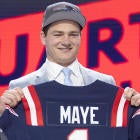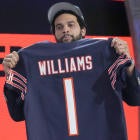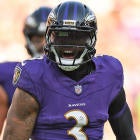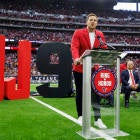Geno Smith stinks.
Admit it, that's what most of you think. You look at his stats, his two-year record, and you immediately think the kid is a disaster and has no chance as the starting quarterback for the New York Jets.
I have news for you: The 2014 tape says otherwise. It doesn't say he's a slam-dunk to be a 10-year starter for the Jets, or even a Pro Bowl player in the near future. What the tape shows is that Smith has a chance to be a solid NFL starter who could grow into more with a little time.
Maybe that's why first-year Jets offensive coordinator Chan Gailey proclaimed Smith the starter two weeks ago, although coach Todd Bowles later said it would be an open competition with Smith getting the first shot to be the starter. Veteran Ryan Fitzpatrick and rookie Bryce Petty are the other challengers.
The Jets are doing the right thing by giving Smith the first chance. Fitzpatrick is a stopgap at best, and he's coming off a season cut short by a broken leg. Smith is learning a new offense, which is challenging, but at least he has more weapons with the addition of Brandon Marshall and rookie Devin Smith to go with Eric Decker and Jeremy Kerley.
Smith has started 29 games in his two seasons with the Jets after being a 2014 second-round pick with a record of 11-18, which isn't good considering the Jets have been a good defensive team in those years. Smith has 25 touchdown passes and 34 interceptions and a completion percentage of 57.5, not exactly the type of numbers a team wants to see from a starting passer.
There are signs of hope in the numbers, though. He threw six touchdown passes and three interceptions in the last six weeks of the 2014 season. His completion percentage in those games was 65.7 percent, which would place him in the top-10 in the league if he could do that over the course of a regular season. Over the last four weeks, Smith went 2-2 and threw for 358 yards, three scores and no picks in a 37-24 victory over Miami in the season finale.
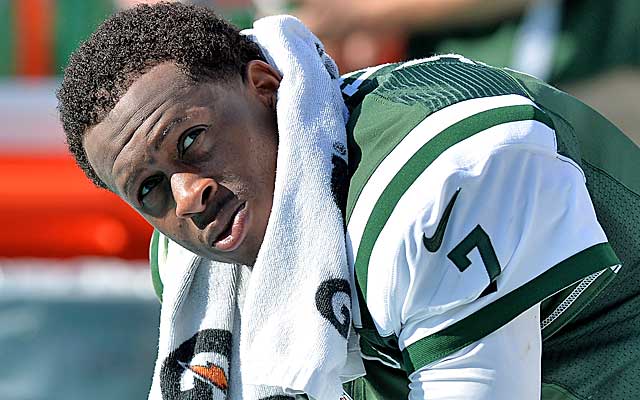
I went back and studied that game, as well as his Week 16 loss to the New England Patriots and two earlier games, a Week 4 loss to the Lions and a Week 5 disaster that saw him benched against the San Diego Chargers after going 4-of-12 for 27 yards and an interception.
Early in the 2014 season, Smith wasn't nearly as sure about what he was seeing from the defense, and his hesitation turned into trouble. He forced the ball at times and his mechanics waned with pressure, forcing him to be inaccurate.
In the final two games I watched, that was changed. He was much more sure of what he was seeing and his mechanics were better, thus his accuracy improved. One thing I really liked on tape when watching Smith was how he moved in the pocket when pressure was around him, but did so to re-load -- not to get out and run.
That's a curse that a lot of young quarterbacks have in their early years. They feel pressure, sometimes it's phantom pressure, and they want out. It's one read and run. With Smith, I saw a quarterback who felt the pressure and moved to throw, rather than take off and run.
There's a play in the Miami game in Week 17 from the third quarter where Smith's first read inside was taken away by the zone, two-deep look. With pressure coming from the outside, he stepped up and made a nice throw for a 50-yard completion to Decker. There was room for Smith to run, but he likely wouldn't have picked up the first down on a third-and-10 play. So when he was flushed, he kept his head up, took a shot, and it turned into a big play.
There was much more of that as in the final five weeks. That's growth. He also did a better job of being patient and checking the ball down when his initial reads weren't there. That's smart. There is nothing wrong with a check-down when the first few reads aren't available. That's a mantra for a lot of good quarterbacks.
Another thing that improved was his pre-snap reads. Take a look at this play against Miami from the Week 17 game as an example.
Play: Third-and-10 at the Miami 26 with 11:45 left in the third quarter.
Offense: Posse (3WR, 1RB, 1TE) -- Back motioned out for an empty backfield with Smith in shotgun.
Defense: Nickel, man-to-man, zero coverage, six-man rush.
Smith took the snap with the knowledge that Cameron Wake would be a free runner from his right as Miami came with a six-man pressure. There was nobody to block Wake. So the ball had to get out fast. When he motioned running back Bilal Powell wide left, and safety Jordan Kovacs went with him, he knew he had man coverage.
The play called for Powell to run hard inside and for Decker, lined up in the slot, to run a deep go route outside of him with the hope that it would be a little bit of pick play. As it turned out, Decker beat Cortland Finnegan early with a slight push and was able to get wide open. Smith stood in with Wake bearing down from his right and Dion Jordan pushing D'Brickashaw Ferguson into his face. He lofted a nice throw off his back foot that Decker hauled in for a 74-yard touchdown catch. The recognition was the key to the play. He saw it, read it, and then threw it. That's quarterbacking.
Another thing I noticed about Smith later in the season was that he moved his head better, which means he read the field better. He would come off his first read quicker to get to the second and even the third. That's progress. That's a must in the modern NFL with so many pressure packages coming at a quarterback and different exotic looks in the secondary.
Here's a look at one of those plays against the Patriots in Week 16.
Play: Second and 10 at the Jets 26 with 10:04 left in the second quarter.
Offense: Posse (3WR, 1TE, 1RB Percy Harvin) -- Shotgun
Defense: Nickel, man-under, single-high safety
On this play, the Jets had Kerley in the slot on the right. Logan Ryan had him in man coverage. Kerley used a nice stop-and-go move to get open across the field. But what made the play was Smith's patience. You can see he wanted to go to Decker on a pivot route to the right, but Darrelle Revis ate it up. That forced Smith to come back to his left and hit Kerley with a dart for an 18-yard gain. What I liked about Smith on the play was the way he reset his feet before firing the ball to Kerley.
Earlier in the season he wasn't as decisive getting off his initial reads. Here's a look at one such play that resulted in a pick against the Lions.
On the play, Smith looked to his left initially to try and get the ball to Decker. But Decker was taken away by the Lions' zone look. If Smith had quickly come off Decker to his right, he would have seen Greg Salas open on a curl route. But he took too long. When he finally did come off Decker to make the throw to Salas, he had Ziggy Ansah bearing down on him and the ball sailed. Darius Slay picked it off for an easy turnover.
Those are the types of plays Smith made as a rookie in 2013 and again early last season. But there were fewer of those types of mistakes in the final six games. He was more precise with his decisions. There was less hesitation on his throws. That's why I think there is potential for him. Now he has to take it to an even higher level.
If he doesn't, Smith will be benched at some point for Fitzpatrick or rookie fourth-round pick Petty and his Jets career will be over. That's what most expect will happen. I am not so sure.
Geno Smith does some things that make you think he has a chance to be a solid NFL starter and late in 2014 he actually started to look like one. It's the right decision to see if he can be that guy for the long run. Let him play it out this season. The Jets have to find out if he's the guy.













